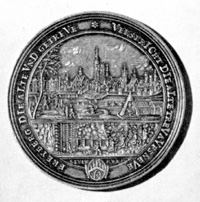Numismatic Map of Ukraine:

There was no possibility of minting coins in the period of feudal fragmentation from the late eleventh to thirteenth centuries. There was a so-called coinless period, when the treasury issued only hryvnias , silver ingots from 160 (in Kyiv) to 200 grams (in Chernihiv and Novgorod). Then a new tradition was established such that the hides of martens, foxes, and squirrels, as well as beaver and bear skins became the equivalent of money.
The consequences of the Mongol Tatar invasion significantly undermined the economy. As a result, the lands of Ukraine became a tasty tidbit for the neighboring states of the Grand Duchy of Lithuania and the Kingdoms of Poland and Hungary. From the early fourteenth century on, Lithuania controlled most of the Ukrainian principalities (of modern Podillia, Volyn, Kyiv, and Chernihiv oblasts).
In August 1385 Lithuania concluded in the Belarus town of Krevo a union with Poland, placing Ukraine and Belarus under the domination of a new federal state, the Rzeczpospolita , for almost four centuries. Ukraine's minting facilities began to orient themselves exclusively toward the legal tenders of Lithuania and Poland.
From the mid-fourteenth century, Ukraine began to be flooded with high-purity (930 fine) Prague groschen . Rich silver mines allowed Czech kings to mint up to million and a half groschen a year. Most European countries also issued groschen patterned on those minted in Prague.
Yet, the combination of too large denominations (gold coins and very small silver denarii , and even groschen weighing under 4 g in total) failed to meet the demands of a developing market. More flexible monetary units were required.
At the beginning of the fourteenth century the Ukrainian lands saw thalers , the ancestors of silver dollars (weighing from 27 to 32 g, with a purity of 800 to 940 fine silver). These coins, called the coins from Joachim's Valley ( joachimsthalers ) after a Czech town, begin to gradually capture the markets of Europe, especially after a huge quantity of silver began to arrive from the Americas.
Treasure troves, still being found on the territory of Ukraine, quite often contain thalers and their fractions (1/4, 1/2, 1.5, two, three, four, and even five thaler coins). In the sixteenth and seventeenth centuries Ukraine played host to the coins of numerous German states, Dutch provinces, Switzerland, and, much more rarely, of Lithuania and Poland, with the Lithuanian coins always being of a higher quality than Polish. Small-denomination coins ( boratinki ), also often occur in the troves. Gold coins (ducats, gold guilders) and silver coins were in circulation in the sixteenth and seventeenth centuries as full equivalents, varying a little in their value: from 10:1 to 12:1.
The prerequisites for the renaissance of Ukrainian statehood in the mid-seventeenth century also inspired hope for the revival of a national currency.
№37 October 05 1999 «The
Day»
In using our publications, reference to The Day is
mandatory. © "День"
Newspaper output №:
№37, (1999)Section
Culture





